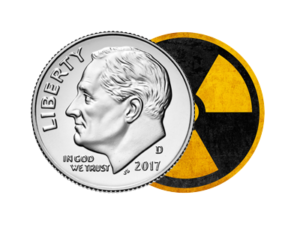
It’s hard to visualize millions of tons of anything so let’s reduce the question to something simple and personal. How much CO2 and various types of pollution are released when a coal plant generates enough electricity to power your home for a month? At an average American home consumes about 30 kilowatt hours (kwh) of electricity per day, which comes out to roughly 1,000 kilowatt hours per month, or 1 megawatt hour (MWh).
First of all, how much coal is burned to generate 1,000 kWh?
Our lightbulb will need 876 kilowatt hours of electricity for its year of operations. Assuming an average power plant efficiency of 37%, our lightbulb will require 800 pounds of coal (see: How much coal does it take to power a 100-watt lightbulb?).
So, for this hot tub sized pile of coal, what kind of unpleasant byproducts can we expect? Here’s a quick synopsis:
- 2.4 pounds of sulfur dioxide
- 1.5 pounds of nitrogen oxides
- 186 pounds of coal ash
- 0.64 ounces of uranium and thorium
- 1,680 pounds of carbon dioxide (how can that be?)
- 1/66th drop of mercury (nasty stuff)
For those of you that like to see the math or understand how more CO2 is created than the original weight of coal, you can follow along below.
2.4 pounds of sulfur dioxide pollution is emitted
Let’s start with sulfur dioxide (SO2), one of the main causes of acid rain. The US Energy Information Agency (EIA) reports that coal was responsible for 90% of the almost 2 million short tons of SO2 emitted by the electricity sector in 2017.
Each 1,000 kWh of coal-powered electricity results in 2.4 pounds of SO2, which is down from 14.6 pounds in 1997. This decline is due to a 30% reduction in the use of coal over that time and, more importantly, coal plants complying with the Clean Air Act Amendments (CAAA) of 1990.
1.5 pounds of nitrogen oxides are created
What about nitrogen oxides (NOx)? These pollutants create acid rain and smog. The electricity sector emitted about 1.6 million short tons of NOx in 2017, with 76% coming from coal-fired power plants.
For each 1,000 kWh of electricity generated from coal plants, 1.5 pounds of NOx is created and released. This is down from 6.4 pounds in 1997.
186 pounds of coal ash is left over
Coal ash is the solid byproduct left over from burning coal. It is the second largest waste stream in the US, topped only by trash. According to the EPA and the American Coal Ash Association, coal power plants created just under 130 million tons of ash in 2014. This means burning enough coal to generate 1,000 kWh leaves 186 pounds of coal ash. Coal ash contains trace amounts of various toxic materials including chromium, arsenic, chlorine, chromium, lead, as well as uranium and thorium.
129,684,142 tons of coal ash in 2014 ÷ 851,000,000 tons of coal burned in 2014 = 0.1523902961 tons of ash per ton of coal burned 0.1523902961 pounds of ash per pound of coal burned (same ratio) × 800 pounds of coal to power a 100 watt lightbulb for a year = 121.91223688 pounds of ash created
In the US, most coal ash is captured and is no longer released into the air. Instead, it is often mixed with water and kept in nearby slurry ponds.
0.064 ounces of radioactive uranium and thorium
The geologic processes that create coal concentrate a range of trace materials into these black rocks. A study by the US Geologic Survey of 2,300 coal sites found the majority had concentrations of uranium between 1 and 4 parts per million. Similar results were found for thorium. Averaging this to 2.5 ppm for both elements leaves us with 5 ppm of radioactive materials per ton of coal.
A concentration of 5ppm in a ton of coal means about 0.01 pound, or 0.16 ounces, or 4.5 grams of radioactive materials. Therefore, the 800 pounds of coal required to power our lightbulb will leave behind 0.064 ounces of uranium and thorium, a little less than the weight of a dime.
In some places, the concentrations can be 6-7 times higher – so high that at least one mining company is finding it cheaper to extract uranium from coal ash than uranium mines.
0.0000005 (same as 5 ppm) concentration of U and Th per ton of coal × 2,000 pounds per ton × 16 ounces per pound = 0.16 ounces of U and Th per ton of coal 0.16 ounces of U and Th per ton of coal x 800 lbs of coal to power lightbulb ÷ 2,000 lbs per ton = 0.064 ounces of U and Th in 800 pounds of coal
Just how dangerous is this radiation? Most research says not much at all. Remember, there is already a lot of natural background radiation and all the material from coal ash is caught and stored within the plant (at least in the US). So, even if you live within a mile of a coal plant, you will only increase your exposure to radiation about 5% a year, less than an x-ray.
More interesting is that nuclear plants have far less radiation. A widely cited paper by Alex Gabbard, of Oakridge National Laboratory, found that the radioactivity outside a coal plant is up to 100-times higher than a nuclear plant. This is largely due to the safety regulations governing the nuclear industry (see: What are the risks of radiation from nuclear power plants?)
1,670 pounds of carbon dioxide
Coal’s most notorious byproduct is carbon dioxide (CO2). Every million BTUs released from burning coal releases an average of 208 pounds of CO2 (see note below). Since a ton of coal has 20.025 million BTUs, that means it creates 4,172 pounds of CO2 when it is burned. Running our 100-watt bulb for one year will produce 1,670 pounds of CO2.
But wait, how can 800 pounds of coal produce twice its weight in CO2? Another article from the EIA explains this in detail but, in short, it’s because the carbon atoms in coal are each combined with two atoms of oxygen from the air to form the CO2. In other words, the extra weight comes from pulling in material for the air.
At room temperature and pressure, 1670 pounds of CO2 would fill three 18-wheeler trucks.

20.025 million BTUs per ton
× 208.364 pounds per million BTUs
= 4,172.4891 pounds of CO2 per ton of coal
= 1,668.99564 pounds of CO2 per 800 pounds of coal
Note: this math is based on weighted average data. The specific amount of CO2 released varies with the kind of coal. US plants burn 45% bituminous, 47% subbituminous, and 7% lignite coal (source: EIA). They release 205.7, 214.3, and 215.4 pounds of CO2 per BTU, respectively (source: EIA). The weighted average is 208.364.
1/66th drop of mercury
OK, this one will take some work but it’s important to do because some forms of mercury can be really nasty stuff. Coal plants account for half of all human-released mercury (source: EPA). Mercury is a heavy metal and a potent neurotoxicant. The type of mercury in thermometers carries some health risks but when it is released into the atmosphere, it combines with other elements and can easily create far more toxic variants.
There is a widely told story of a researcher, Karen Wetterhahn, who tragically died after only a drop or two of a particularly lethal compound of mercury fell on her hand. Despite wearing latex gloves, the mercury seeped through to her skin in a matter of seconds and she later died. This story is meant to be illustrative and drive home the health risks of mercury. It is not a scientific study or safety evaluation. But, if you want to look at the math and see how it works for yourself, read on…
An EPA report called The National Emissions Inventory (page 2-30) estimates that 22.9 tons of mercury were released from coal-fired power plants in 2014 (note that other environmental studies put this number 2-4 times higher). This means that 0.00000002809816 tons of mercury, or 0.00005619632 pounds of mercury, or 0.02549065075 grams of mercury comes from each ton of coal.
22.9 tons of mercury ÷ 851 million tons of coal = 0.00000002809816 tons of mercury per ton of coal 0.00000002809816 tons × 2000 pounds per ton = 0.00005619632 pounds of mercury per ton of coal 0.00005619632 pounds × 453.6 grams per pound = 0.02549065075 grams of mercury per ton of coal
Since pharmacists define 0.05 milliliters of liquid as a drop and 1 gram of mercury fills 0.073888 milliliters (mercury conversion), one ton of coal contains 0.03766906406 drops of mercury.
0.02549065075 grams of mercury per ton of coal
× 0.073888 milliliters per gram
= 0.001883453203 milliliters of mercury per ton of coal
0.001883453203 milliliters of mercury per ton of coal
÷ 0.05 milliliters per drop
= 0.03766906406 drops of mercury per ton of coal
Our lightbulb takes 800 pounds, or 0.4 tons of coal, which means burning it creates 0.01506762562 drops of mercury or rounding it a bit, 1/66th of a drop.
0.02549065075 drops of mercury per ton of coal
× 0.4 tons of coal to power a 100 watt lightbulb for a year
= 0.01506762562 drops of mercury per 100 watt lightbulb per year
1 ÷ 0.01506762562 drops = 66.36 or 1/66th
Additional Reading
- The US Energy Information Administration annual report on coal
- From the Freeing Energy Project: Five trends that will lead to the end of fossil fuels
Caveats
Note: There are numerous sources of information on the topic of coal byproducts. The math is shown here to help explain how our numbers were derived but it is inevitable that other approaches will yield different results. If you find a glaring mistake, please let us know in the comments below.
Also note: we use the US government data wherever possible. Many environmental groups do their own studies and find pollution is often worse than reported by the government. Our goal here is to bring as many people as possible into these conversations so we avoid using data that could be dismissed as aggressive.





